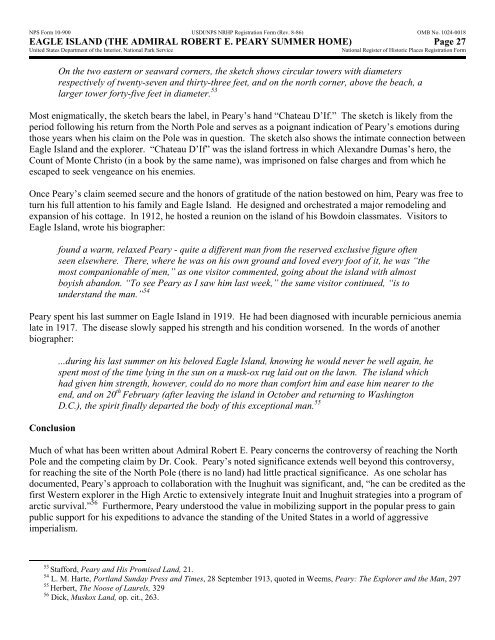Nomination - National Park Service
Nomination - National Park Service
Nomination - National Park Service
You also want an ePaper? Increase the reach of your titles
YUMPU automatically turns print PDFs into web optimized ePapers that Google loves.
NPS Form 10-900 USDI/NPS NRHP Registration Form (Rev. 8-86) OMB No. 1024-0018<br />
EAGLE ISLAND (THE ADMIRAL ROBERT E. PEARY SUMMER HOME) Page 27<br />
United States Department of the Interior, <strong>National</strong> <strong>Park</strong> <strong>Service</strong><br />
<strong>National</strong> Register of Historic Places Registration Form<br />
On the two eastern or seaward corners, the sketch shows circular towers with diameters<br />
respectively of twenty-seven and thirty-three feet, and on the north corner, above the beach, a<br />
larger tower forty-five feet in diameter. 53<br />
Most enigmatically, the sketch bears the label, in Peary’s hand “Chateau D’If.” The sketch is likely from the<br />
period following his return from the North Pole and serves as a poignant indication of Peary’s emotions during<br />
those years when his claim on the Pole was in question. The sketch also shows the intimate connection between<br />
Eagle Island and the explorer. “Chateau D’If” was the island fortress in which Alexandre Dumas’s hero, the<br />
Count of Monte Christo (in a book by the same name), was imprisoned on false charges and from which he<br />
escaped to seek vengeance on his enemies.<br />
Once Peary’s claim seemed secure and the honors of gratitude of the nation bestowed on him, Peary was free to<br />
turn his full attention to his family and Eagle Island. He designed and orchestrated a major remodeling and<br />
expansion of his cottage. In 1912, he hosted a reunion on the island of his Bowdoin classmates. Visitors to<br />
Eagle Island, wrote his biographer:<br />
found a warm, relaxed Peary - quite a different man from the reserved exclusive figure often<br />
seen elsewhere. There, where he was on his own ground and loved every foot of it, he was “the<br />
most companionable of men,” as one visitor commented, going about the island with almost<br />
boyish abandon. “To see Peary as I saw him last week,” the same visitor continued, “is to<br />
understand the man.” 54<br />
Peary spent his last summer on Eagle Island in 1919. He had been diagnosed with incurable pernicious anemia<br />
late in 1917. The disease slowly sapped his strength and his condition worsened. In the words of another<br />
biographer:<br />
Conclusion<br />
...during his last summer on his beloved Eagle Island, knowing he would never be well again, he<br />
spent most of the time lying in the sun on a musk-ox rug laid out on the lawn. The island which<br />
had given him strength, however, could do no more than comfort him and ease him nearer to the<br />
end, and on 20 th February (after leaving the island in October and returning to Washington<br />
D.C.), the spirit finally departed the body of this exceptional man. 55<br />
Much of what has been written about Admiral Robert E. Peary concerns the controversy of reaching the North<br />
Pole and the competing claim by Dr. Cook. Peary’s noted significance extends well beyond this controversy,<br />
for reaching the site of the North Pole (there is no land) had little practical significance. As one scholar has<br />
documented, Peary’s approach to collaboration with the Inughuit was significant, and, “he can be credited as the<br />
first Western explorer in the High Arctic to extensively integrate Inuit and Inughuit strategies into a program of<br />
arctic survival.” 56 Furthermore, Peary understood the value in mobilizing support in the popular press to gain<br />
public support for his expeditions to advance the standing of the United States in a world of aggressive<br />
imperialism.<br />
53<br />
Stafford, Peary and His Promised Land, 21.<br />
54 L. M. Harte, Portland Sunday Press and Times, 28 September 1913, quoted in Weems, Peary: The Explorer and the Man, 297<br />
55<br />
Herbert, The Noose of Laurels, 329<br />
56 Dick, Muskox Land, op. cit., 263.
















